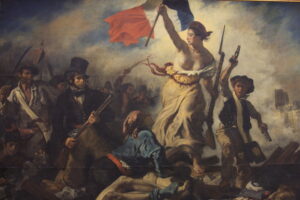1 The Study of Revolution
Gregory Young

“The hopeless don’t revolt, because revolution is an act of hope.”
-Peter Kropotkin
There have been many attempts by scholars to formulate universal theories that explain how revolutions develop and predict their success or failure, yet most have yielded disappointing results. I begin my class on revolutions by asking my students that question, “Why do Men Rebel?” An interrogative variation of Ted Gurr’s eponymous book, Why Men Rebel (Gurr, 1970). Inevitably, I am barraged with responses like, “they have no economic opportunity, they face violence or a corrupt government, or there is a democratic deficit. These environmental or structural factors the students contend are the most important independent variables to predict a revolutionary situation (a group of people engaged in protest or insurrection). But these factors do not seem to do well to predict revolutionary outcomes (the reform or governmental change that follows the revolutionary situations). Using structural explanations, revolutions are the attempts of normal people responding to abnormal situations. Any group of people faced with the same difficult circumstance would react in the same manner.
These structural or environmental factors are clearly important in predicting revolution to several theorists who occupy a lofty position in the canon of the literature. Karl Marx believed as societies advance, they compete over the control of the means of production, and that capitalist exploitation will inevitably lead to a revolution of the proletariat. The actors do not matter; they march lock-stop according to Hegel’s dialectic. Other structuralists include neo-Marxist, Barrington Moore and his PhD students Theda Skocpol and Charles Tilly (Moore,1966, Skocpol, 1979, Tilly, 1992).
Later in the semesters, when the class examines the Arab Spring, and looks for causes that caused protests to erupt almost simultaneously across twelve Arab states in 2011, inevitably they cite the same litany of structural causes. When confronted with the evidence that these conditions have existed in these countries for decades, I ask these same students, “Why revolt now?” What is it that turns these environmental features into action? With that the class begins to examine the actor-oriented theories or the agency that acts within the structure. From Gurr’s “relative deprivation” which expands in scope and intensity to Trotsky’s “Vanguard of the proletariat”, students find it takes abnormal citizens to motivate the masses to react to the normal misery that the structures can bring. Was Hitler the personification of Thomas Carlyle’s “Great Man” theory (great meaning important not morally good) that persuaded the German people to respond to the depredations of the Versailles Treaty and the depression to elect him Chancellor (Carlyle 1840).
At this point those in my classes have moved to what Chalmers Johnson describes as “conjunction theories”, those that combine elements of both structure and agency. Crane Brinton sets out in his uniformities of revolutions, structural elements like economic growth which leads to unmet rising expectations. Actor oriented elements include the necessary defection of the intellectuals when the old ruling class begin to distrust themselves or lose faith in their traditions (Brinton, 1965).
An oft overlooked element for study is the theories of counter revolution and the topic that almost developed a cult following of late, theories of counterinsurgency (COIN). Classical theorists of war like Clausewitz and Jomini can be compared to more contemporary revolutionary writers like Mao and Che Guevara. The decisions to use maximum military force to destroy the insurgency or minimum force to win the “hearts and minds) of the citizens can be used to examine multiple intrastate conflicts currently around the globe. Dr. John Nagl uses both organizational and national strategic culture to explain why one or the other of these strategies were adopted by the UK or the US in Malaya and Vietnam (Nagl, 2005).
At the outset, they believe that revolutions are the causes of change. But, by the end of the semester, these same students are more likely to believe that change is the cause of revolutions. Particularly, the government’s inability to respond to change. In each revolutionary situation, there are generally those on the left who are trying to alter economic, social, and political structures and relationships and those on the right who wish to protect the status quo or return to a previous status quo.
At the end of the day, these young scholars have developed a nuanced and multi-faceted understanding of the underlying structure as well as the actions of certain citizens that can cause people to go out into the street and call for economic, social, and political change. Additionally, they can predict when those calls for change will be successful.
The first several chapters of this text will lay the groundwork by examining the key classical theorists in the study of both revolutionary situations and revolutionary outcomes. Then these theories will be applied to the French and Russian revolutions. This work will then examine counterinsurgency and counter revolution and apply it to case studies in Malaya, Vietnam, and Algerian revolutions. As the course moves to more contemporary uprisings the international component is included that is the key for theorists like James Defronzo (Defronzo, 2012).
Works Cited
Brinton, Crane, The Anatomy of a Revolution. Vintage Press, 1965.
Carlyle, Thomas (1840 (1993)), On heroes, hero-worship, and the heroic in history. Berkeley CA: UC Press.
DeFronzo, J. (2011). Revolutions and revolutionary movements. Boulder, CO: Westview Press.
Gurr, Ted (1970), Why Men Rebel. Princeton, NJ: Princeton University Press.
Moore, Barrington (1966). Social Origins of Dictatorship and Democracy. Boston: Beacon Press, pp. xxi-480.
Nagl, John A. Learning to Eat Soup with a Knife: Counterinsurgency Lessons from Malaya and Vietnam. Chicago, IL: University of Chicago Press, 2009.
Skocpol, Theda, States and Social Revolutions. Cambridge University Press, 1979.
Tilly, Charles. (1993), European Revolutions 1492-1992. Blackwell Publishers
Image Attribution
“Liberty Leading the People” by Eugene Delacroix is in the public domain
